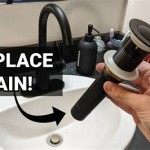Why Does My Bathroom Smell Like Dead Fish?
The persistent and unpleasant odor of dead fish emanating from a bathroom is a cause for concern. While seemingly unusual, several factors can contribute to this disconcerting aroma. Identifying the root cause requires a systematic approach, considering various potential sources within the bathroom and its plumbing system. This article will explore the common reasons behind a fishy smell in a bathroom, providing insights into how to diagnose and address the issue effectively.
The presence of a fishy smell often indicates the presence of decaying organic matter, chemical reactions, or problems within the plumbing infrastructure. Prompt investigation is essential not only to eliminate the unpleasant odor but also to prevent potential health hazards and structural damage to the property. Ignoring the smell can lead to the problem worsening over time, resulting in more extensive and costly repairs.
Sewer Gas Leaks and Their Connection to Fishy Odors
One of the primary suspects behind a fishy smell in the bathroom is sewer gas leakage. Sewer gas is a complex mixture of gases that includes methane, hydrogen sulfide, ammonia, and other volatile organic compounds. While typically described as smelling like rotten eggs due to the presence of hydrogen sulfide, under certain conditions, the combination of gases can produce a distinctly fishy aroma. Sewer gas is produced by the decomposition of organic waste in sewage systems.
Several factors can cause sewer gas to escape into the bathroom. A common culprit is a dried-out P-trap. The P-trap is the curved section of pipe located under each sink, toilet, shower, and bathtub. Its purpose is to hold a small amount of water, creating a seal that prevents sewer gases from entering the building. If a P-trap is not used regularly, the water can evaporate, breaking the seal and allowing sewer gas to seep into the bathroom. This is particularly common in guest bathrooms or infrequently used fixtures.
Another potential cause of sewer gas leaks is a damaged or improperly installed plumbing vent. Plumbing vents are pipes that extend from the drainage system to the roof of the building. Their purpose is to allow air to enter the drainage system, preventing a vacuum from forming when water drains. When a vacuum forms, it can siphon water out of the P-traps, breaking the seal and allowing sewer gas to enter. If the vent is damaged, blocked by debris (leaves, bird nests), or improperly installed, it can compromise the ventilation of the plumbing system and contribute to sewer gas leaks.
Cracked or damaged drain pipes are also a significant source of sewer gas leaks. Over time, drain pipes can corrode, crack, or develop leaks, allowing sewer gas to escape into the surrounding environment. These leaks can be difficult to detect, especially if the pipes are concealed within walls or under the floor. A professional plumber can use specialized equipment, such as smoke testing or video inspection, to locate hidden pipe leaks.
Furthermore, problems within the septic system, in properties not connected to municipal sewer lines, can generate unusual odors that permeate into the house, including a fishy smell. A septic tank that is overflowing or improperly maintained can release unpleasant odors into the surrounding soil and potentially into the plumbing system if backflow occurs. This situation requires immediate attention to prevent environmental contamination and health hazards.
Biofilm Formation and Microbial Activity
Biofilm is a thin, slimy layer of microorganisms that can form on surfaces in moist environments, such as drain pipes, showerheads, and toilet bowls. This biofilm can harbor bacteria and fungi that contribute to unpleasant odors. The specific microorganisms present in the biofilm and the metabolic processes they undergo can influence the type of odor produced.
In some cases, certain types of bacteria within the biofilm can produce volatile organic compounds (VOCs) that have a fishy odor. The breakdown of organic matter, such as hair, soap scum, and food particles, by these bacteria can release amines, which are nitrogen-containing compounds often associated with a fishy smell. These amines can become airborne and contribute to the overall odor in the bathroom.
The accumulation of biofilm can be exacerbated by infrequent cleaning and poor ventilation. Regular cleaning with appropriate cleaning agents can help to remove biofilm and prevent its buildup. Ensuring adequate ventilation in the bathroom by using exhaust fans or opening windows can help to reduce moisture levels, creating an environment less conducive to biofilm growth.
It is important to consider the materials used in plumbing fixtures and fittings, as some materials provide a more hospitable environment for biofilm formation than others. Porous materials, such as certain types of plastic, can be more prone to biofilm growth than non-porous materials, such as stainless steel or ceramic. When selecting plumbing fixtures, choosing materials that are resistant to biofilm formation can help to reduce the likelihood of odor problems.
Furthermore, water quality can influence the composition and activity of biofilm. Hard water, which contains high levels of minerals, can promote biofilm formation. The minerals can provide nutrients for the microorganisms and create a rougher surface for them to adhere to. Installing a water softener can help to reduce mineral levels and minimize biofilm formation.
Electrical Issues and Burning Smells
While less common, a fishy smell in the bathroom can sometimes be attributed to electrical issues. Overheating electrical components, such as wiring, outlets, or light fixtures, can emit a distinct odor that some people describe as fishy or similar to burning plastic. This is usually a serious issue requiring immediate attention.
The insulation surrounding electrical wires is often made from polymers that contain compounds that can release volatile organic compounds (VOCs) when heated. These VOCs can have a distinct odor that resembles fish or burning plastic. Overloaded circuits, loose connections, or damaged wiring can cause the insulation to overheat and release these VOCs.
It is crucial to investigate any electrical issues promptly to prevent potential fire hazards. If a fishy smell is accompanied by other signs of electrical problems, such as flickering lights, sparking outlets, or discolored outlets, it is essential to turn off the power to the affected circuit and contact a qualified electrician immediately. Attempting to repair electrical problems without proper training and equipment can be dangerous and potentially life-threatening.
The source of the electrical odor may not always be immediately apparent. The smell can sometimes be faint and intermittent, making it difficult to pinpoint the exact location of the problem. A qualified electrician can use specialized equipment, such as thermal imaging cameras, to detect overheated electrical components and diagnose the underlying issue.
Preventative measures can help to minimize the risk of electrical problems and associated odors. Ensuring that all electrical installations are performed by qualified professionals and that electrical systems are regularly inspected can help to identify and address potential issues before they escalate. Avoid overloading circuits by plugging too many appliances into a single outlet. Regularly check outlets and light fixtures for signs of damage or discoloration.
In addition to the above-mentioned causes, there are less frequent but still possible contributors to a fishy smell in the bathroom. These include:
*Reactions between cleaning products:
Mixing certain cleaning products, especially those containing bleach and ammonia, can produce dangerous and foul-smelling gases. Avoid mixing cleaning products and always follow the manufacturer's instructions. *Dead animals:
While less common in modern homes, a dead animal (rodent, bird, etc.) trapped in the walls or under the floor can decompose and produce a strong, unpleasant odor. This usually has a clear rotting smell in addition to the fishy smell. *Contaminated water supply:
In rare cases, the water supply itself may be contaminated with substances that produce a fishy odor. Evaluate the water source for any discoloration, unusual smells, or changes in taste. Have the water tested to identify any contaminants. *Chemical interactions with plumbing materials:
Certain chemicals, especially those found in some drain cleaners, can react with the materials in the plumbing system, such as PVC or copper, and produce a fishy odor. *Certain types of mold:
Although most molds present a musty smell, some mold species can emit strange odors, and in some cases the smell has been described as fishy. *Problematic wax ring:
A compromised wax ring at the base of the toilet can leak sewage and create odors. *Adhesives used in construction:
Some adhesives used during construction or renovation can emit strong chemical odors that might be perceived as fishy during initial off-gassing.Identifying the specific source of a fishy smell in the bathroom requires a methodical approach. Start by examining the most likely culprits, such as the P-traps and drain pipes. Check for any signs of leaks or damage. If the source is not immediately apparent, consider enlisting the help of a qualified plumber or electrician to conduct a more thorough inspection. Addressing the underlying cause of the odor is essential to restoring a healthy and pleasant environment in the bathroom.

Help My Toilet Smells Like Fish

Beware Of The Fishy Smell In Your Home My Trusted Expert

Fish Smell In Your Bathroom It S Probably This

Why Do We Find The Fishy Smell In Bathroom Livingproofmag

Fish Smell In Your Bathroom It S Probably This

Fish Smell In Your Bathroom It S Probably This

Common Causes Of Fishy L Odor And What To Do About It

Fish Smell In Your Bathroom It S Probably This
Fishy L Odor What Causes It And How To Treat

Bathroom Smells Fish Tiktok Search
Related Posts







